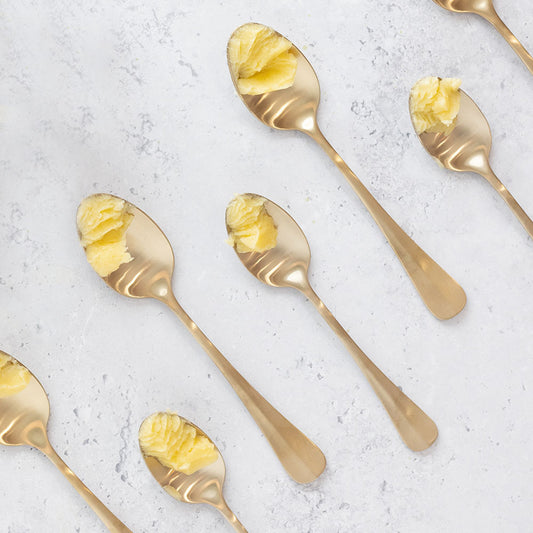How to Make Ghee

Heat one pound of unsalted organic butter over low heat in a heavy-bottomed pot. During this entire process, do not stir butter at all. The butter will begin to simmer and will make a little crackling noise. After about 15–20 minutes, there will be a thin covering on the top and a thicker, curdy sediment stuck to the bottom of the pot. At this point you need to watch the
very carefully so it doesn't burn. When the crackling sound has almost entirely stopped; the butter is a completely clear, beautiful golden color through to the bottom, and there are only a few air bubbles on the surface, it is done. Let it cool for an hour and then strain it carefully into a clean, glass container. Be sure that the sediment at the bottom of the pan remains there; it contains the impurities from the butter and can be discarded. The foamy layer on top of the ghee is fine. Ghee can be kept at room temperature or refrigerated.
If you don't feel like making ghee, you can buy it at most health food stores or East Indian grocery stores.
COPYRIGHT
The above information was written by Dr. Claudia Welch and edited by Melody Mischke for the exclusive use of Banyan Botanicals. The information is protected by copyright and may not be reprinted without the written permission of Dr. Claudia Welch and Banyan Botanicals. More about Dr. Claudia Welch
More for You
Shatavari Ghee Recipe
Medicinal ghee has been used in Ayurveda for thousands of years. Shatavari has a special affinity to nourishing and supporting the female reproductive system, and ghee is an excellent vehicle for carrying herbs to the deeper tissues of the body. The combination allows for a wonderful way to utilize the full potential of this rejuvenating herb.
How to Make Kitchari
Perfect for cleansing, kitchari is an ideal food of choice during times of stress on the body, such as during periods of overwork or seasonal transitions.



